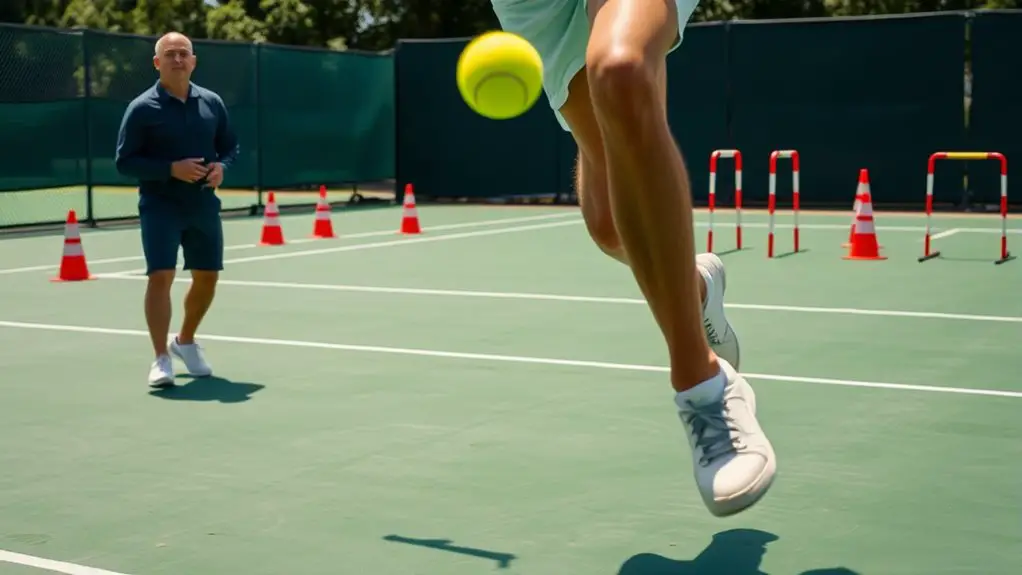Strength training for sprinters focuses on boosting explosive power and speed through high-intensity workouts, while distance runners prioritize endurance with higher-rep, lower-weight exercises. Sprinters develop fast-twitch fibers for quick bursts of speed, incorporating plyometrics and Olympic lifts. In contrast, distance runners cultivate slow-twitch fibers for stamina, relying on exercises that enhance overall strength and flexibility. Both approaches aim to prevent injuries and improve performance, but their methods differ greatly. You'll discover more about their specific training goals and exercises.
The Importance of Strength Training in Running
While you might think of running as purely an aerobic activity, incorporating strength training is essential for all runners. It's not just about hitting the pavement; building muscle strength can greatly enhance your running performance. When you engage in strength training, you're not only boosting your speed but also improving your endurance. Stronger muscles help you maintain form over longer distances, reducing fatigue and the risk of injury.
Consider the strength training benefits like enhanced power and better overall stability, which are important whether you're sprinting or going for a long jog. Stronger legs mean a more efficient stride, allowing you to cover more ground with less effort. Plus, the confidence gained from strength workouts can empower you mentally, giving you the freedom to push your limits. Incorporating deadlifts into your routine can lead to better performance and injury prevention. So, embrace strength training as a key part of your running journey; it'll elevate your performance and make every run more enjoyable.
Key Differences in Muscle Fiber Composition
When it comes to muscle fiber composition, sprinters and distance runners show some key differences. Sprinters typically have a higher proportion of fast-twitch fibers, which help with explosive power, while distance runners often rely on slow-twitch fibers for endurance. Understanding these variations can help you tailor your strength training to better suit your running style. Additionally, strength training can enhance power output, benefiting sprinters significantly.
Muscle Fiber Types
Muscle fiber types play an essential role in determining how sprinters and distance runners train and perform. Your muscle fiber composition and fiber type distribution greatly influence your athletic capabilities. Here's how they differ:
- Fast-twitch fibers: Sprinters rely on these for explosive power and speed.
- Slow-twitch fibers: Distance runners use these for endurance and sustainable energy.
- Hybrid fibers: Some athletes possess a mix, allowing versatility in training and performance.
- Adaptability: With specific training, you can enhance the dominant fiber type, improving your chosen sport.
Understanding these differences can empower you to tailor your training for ideal results, embracing your unique strengths and enjoying your running journey.
Training Adaptations Differences
Training adaptations vary considerably between sprinters and distance runners due to their differing muscle fiber compositions. Sprinters primarily develop fast-twitch muscle fibers, which enable explosive power and speed, leading to enhanced performance outcomes in short bursts of activity. On the other hand, distance runners cultivate slow-twitch fibers that support endurance and stamina, allowing them to sustain effort over longer periods.
These adaptations not only influence how you train but also shape your physical capabilities. If you're a sprinter, you'll focus on high-intensity, short-duration workouts to maximize strength and speed. Conversely, as a distance runner, your training will lean towards longer, steady-state sessions to build aerobic capacity. Understanding these differences can help you tailor your training to achieve your personal performance goals.
Strength Training Goals for Sprinters
To excel as a sprinter, you need to focus on strength training goals that enhance explosive power and speed. Your training should prioritize the following:
- Increase Power Output: Utilize Olympic lifts like cleans and snatches to develop explosive strength.
- Muscle Hypertrophy: Incorporate resistance exercises that promote muscle growth, emphasizing the major muscle groups used in sprinting.
- Plyometrics: Integrate jump training to improve your reaction time and enhance your ability to generate force quickly.
- Core Stability: Strengthen your core to guarantee efficient transfer of power through your body, supporting your sprinting technique. Additionally, focusing on proper technique maximizes explosive power and reduces injury risk.
Strength Training Goals for Distance Runners
While sprinters focus on explosive strength, distance runners benefit from a different approach to strength training. Your primary goal is to enhance endurance benefits, allowing you to maintain a steady pace over long distances. This means prioritizing strength exercises that improve muscular endurance rather than raw power. Incorporating higher-rep, lower-weight workouts can help build the stamina needed for those extended runs.
Additionally, integrating effective recovery strategies is essential. You'll want to include flexibility training and active recovery sessions to keep your muscles fresh and prevent injury. Always listen to your body, adjusting your routine based on how you feel. Remember, the key is to find a balance between strength and endurance, enabling you to run further without burning out. Embracing these goals in your training will empower you to experience the freedom of movement you crave on your long-distance runs. Building endurance enhances stamina and boosts confidence, which is crucial for long-distance success.
Types of Exercises for Sprinters
When it comes to sprinters, focusing on explosive power movements is key to enhancing your speed. Incorporating plyometric training techniques can boost your agility and fast-twitch muscle response. Plus, strengthening your core stability will support your overall performance on the track. Additionally, improving nervous system efficiency through plyometric exercises allows athletes to achieve faster muscle response and better performance.
Explosive Power Movements
Explosive power movements are crucial for sprinters, as they enhance speed and acceleration on the track. To achieve ideal power development, incorporating explosive drills into your training is essential. Here are four key exercises you should consider:
- Box Jumps: Propel yourself onto a sturdy box or platform, focusing on explosive upward force.
- Power Cleans: Use this Olympic lift to build strength and speed in one fluid motion.
- Broad Jumps: Leap forward as far as possible, engaging your core and legs for maximum distance.
- Medicine Ball Throws: Explode through your hips and arms to launch the ball, improving overall explosiveness.
Plyometric Training Techniques
Plyometric training techniques are essential for sprinters, as they develop the fast-twitch muscle fibers needed for speed and agility. By incorporating plyometric drills into your routine, you'll enhance your explosive strength and improve your overall performance. Start with exercises like box jumps, where you leap onto a sturdy platform, or depth jumps, which focus on maximizing your power upon landing. Don't forget about bounding, as it mimics the sprinting motion and builds coordination. You can also try single-leg hops to challenge stability while boosting strength. Consistently practicing these drills will help you release your potential and experience that exhilarating freedom on the track. Embrace the power of plyometrics and watch your speed soar!
Strengthening Core Stability
Building on the importance of explosive strength, core stability is another key component for sprinters looking to enhance their performance. A strong core not only supports your speed but also helps maintain proper form. Here are some effective stability exercises you can incorporate into your routine:
- Planks: Hold a plank position to build endurance and strength in your core.
- Russian Twists: Engage your obliques by twisting your torso while holding a weight.
- Medicine Ball Slams: Explode upwards and slam the ball down to develop power and stability.
- Single-Leg Deadlifts: Balance on one leg while lifting weights to improve stability and strength.
Integrating these exercises into your training can boost your core strength and overall sprinting performance, giving you the freedom to run faster.
Types of Exercises for Distance Runners
While distance runners focus primarily on endurance, incorporating specific strength training exercises is essential for enhancing performance and preventing injuries. You'll want to prioritize exercises that build overall strength while complementing your endurance training. Think about including squats and lunges, which not only strengthen your legs but also improve your balance and stability.
Don't overlook the importance of flexibility exercises, like dynamic stretches and yoga. These can help you maintain a full range of motion and reduce tightness that can slow you down.
Additionally, incorporating core workouts, such as planks and medicine ball exercises, will support your posture during those long runs. A strong core helps enhance overall body mechanics, which is crucial for effective movement and injury prevention. Remember, the goal isn't just about building muscle; it's about creating a well-rounded fitness routine that empowers you to run freely and effectively. By integrating these exercises, you'll not only boost your performance but also enjoy the journey of distance running even more.
Injury Prevention Through Tailored Strength Training
Strength training doesn't just enhance performance; it plays a significant role in injury prevention for both sprinters and distance runners. By incorporating tailored strength programs, you can effectively reduce your risk of injury. Here are some key injury prevention strategies to take into account:
- Focus on Core Stability: A strong core stabilizes your body, reducing the risk of falls and strains.
- Balance Flexibility and Strength: Incorporate flexibility exercises to complement your strength training, maintaining muscle elasticity.
- Target Specific Muscle Groups: For sprinters, emphasize explosive strength, while distance runners should focus on endurance and stability.
- Gradual Progression: Increase the intensity of your workouts slowly, allowing your body to adapt and minimize injury risk. Additionally, incorporating dynamic stretching into your warm-up can further enhance muscle readiness and reduce the likelihood of hamstring injuries.
Frequently Asked Questions
How Often Should Sprinters and Distance Runners Strength Train Weekly?
When it comes to strength training frequency, you'll want to take into account your goals and overall training plan. Typically, training two to three times a week is effective for most athletes. However, you'll need to adjust your training session intensity based on your specific needs, whether you're focusing on explosive power or endurance. Listening to your body and ensuring proper recovery can help you find that sweet spot for peak performance.
What Role Does Nutrition Play in Strength Training for Runners?
Nutrition's essential for your strength training success. You need to focus on macronutrient balance; carbs fuel your workouts, while protein aids recovery and muscle growth. Don't forget about healthy fats, too. Hydration strategies are just as important; staying well-hydrated can enhance performance and reduce injury risk. By prioritizing these aspects, you'll feel more energized and ready to tackle your training, giving you the freedom to push your limits and achieve your goals.
Can Strength Training Improve Running Endurance for Sprinters?
Ever watched a cheetah sprint, effortlessly covering ground? You might think strength training's just for power, but it can improve your running endurance too. By focusing on strength adaptations, you'll enhance your muscular endurance, allowing you to maintain speed over longer distances. The endurance benefits will surprise you, as your body learns to cope better with fatigue. So, why not embrace that freedom to run faster and longer with a solid strength routine?
How Can Runners Measure Their Strength Training Progress Effectively?
To measure your strength training progress effectively, you'll want to focus on progress tracking through consistent assessments. Start by establishing strength metrics, like your max lifts or the number of repetitions at a given weight. Regularly test these metrics to see improvements over time. Additionally, keep a training log to note how you feel during workouts. This way, you'll feel empowered to adjust your training plan and celebrate your gains along the way.
Are There Common Misconceptions About Strength Training for Runners?
Strength training for runners can be like steering through a maze; you might get lost in misconceptions. Many believe lifting weights will bulk you up, but that's just a myth debunked. Instead, effective training techniques focus on building endurance and strength tailored to your needs. Embracing the right approach can free you from limitations, enhancing your performance without sacrificing speed. So, let go of those myths and discover how strength training can empower your running journey!




